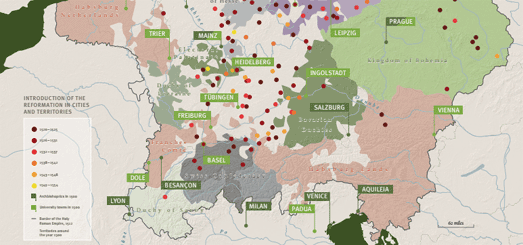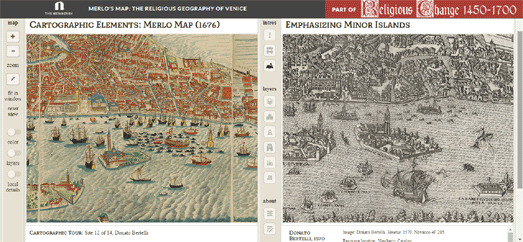500 Years of Protestantism

500 years ago today a little known monk called Martin Luther nailed his Ninety-five Theses to a chapel door in Wittenberg. It was an act that would lead to the Reformation and that would change the world forever. Here I Stand is a website exploring the life and work of Martin Luther, the birth of the Reformation and its lasting effect on the world.
Here I Stand includes a number of interactive and static maps which are used to explore the spread of the Reformation and to explain the world in which Martin Luther lived. These maps include a 3d map of Sixteenth Century Wittenberg, where Martin Luther lived and worked. Although a static map it does include labels (turn them on using the 'discover more' button) which show important locations in the town.

Here I Stand also features a number of interactive maps. These include a map of the Holy Roman Empire showing locations with a Martin Luther connection. Another interactive map shows how the reformation quickly spread through towns and cities in the Holy Roman Empire during the first half of the Sixteenth Century. The Reformation Movement map includes buttons which allow you to filter the cities shown by the date that they introduced the reformation.
If you like the maps featured on Here I Stand you can print them out as PDF map posters.

The Newberry Library in Chicago is currently holding a major exhibition on Religious Change and Print, 1450-1700. In support of this exhibition they have put together an online collection of the Newberry Library's manuscripts, maps and images from the Reformation.
One online contribution to the exhibition is an interactive story map Tracking the Lutheran Controversy. The map explores the role of printing in spreading the ideas of an obscure monk in Wittenburg to the whole of Europe.
Tracking the Lutheran Controversy examines some of the key pamphlets and texts published by Martin Luther (and the papal bulls issued in response). As you progress through Tracking the Lutheran Controversy the map shows how Luther's ideas spread throughout Europe. It also looks at the publication of responses to Luther, both in support and against his beliefs.

The Newberry Library online collection also includes a superb interactive presentation of Giovanni Merlo’s engraved map of Venice from 1676. This interactive version of Merlo's Map includes information about the engraving and some of the Venetian locations depicted in the map. The colored circles on the map pick out some of Reformation Venice's most important churches, monasteries and printing centers. You can click on these circles to learn more about each highlighted location and view other illustrations of the location from the Newberry collection.
If you select the 'toggle maps' button (from the navigation buttons running down the center of the interactive) you can directly compare Merlo's Map side-by-side with other vintage maps of Venice. These other maps include Jacopo de Barbari 1500 map of Venice, Benedetto Bordon's map of 1534 and Paolo Forlani's Venetia from 1566.


Комментарии